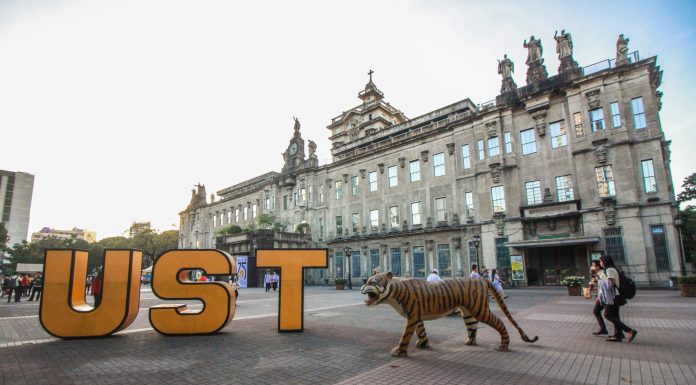FOR YEARS, nobody paid much attention to the intricately carved 17th century bas-relief of the image Our Lady of the Apocalypse hanging on the east nave of the Immaculate Conception Cathedral in Pasig City. Nobody knows the real story behind bas relief, but according to its oral history, it has traveled from Spain to other churches in Manila and finally landed in Pasig. The bas relief depicts the blessed lady standing in a prayerful litany above the crescent moon amid swirling clouds imposed on an aged molave panel like an old and forgotten memory.
But thanks to the efforts of Thomasians Mary Ann Venturina-Bulanadi, Oliver Rabara, and Cheek Fadriquelas, the beauty and the story of the art piece hidden under its marred and dusty façade resurfaced during its re-enthronement last Sept. 8, in time for the Virgin Mary’s birthday.
Devotion
UST Graduate School professor Maita Reyes commissioned the three in October last year to restore the bas-relief in coordination with the cathedral’s comite de festejos (festival committee). Since then, they had devoted most of their time working on the project.
Conservation of an antique entails preservation of its present state and preventing further deterioration. However, restoration of an artwork to its former glory requires very meticulous treatment. And now, technology, hand in hand with research, not only restores old masterpieces but also stories of faith, culture, and heritage.
A seasoned architect and interior designer and curator of the UST Beato Angelico Gallery, Bulanadi was the coordinator of the restoration team. Bulanadi earned her Architecture degree from the then UST College of Architecture and Fine Arts in 1986; her Interior Design degree in the Philippine School of Interior Design in 1991; and her masters degree in Cultural Heritage Studies (CHS) in UST in 2004, when she met her partners in the project. It’s no longer a surprise that she took the opportunity to restore the 17th-century image, being involved in art longer than she could remember.
“I graduated from the Immaculate Conception in Tondo; I have a devotion to Mary.” she explains. “So even though I get exhausted from the long travel from Tondo to Pasig, it’s all worth it in the end.”
She said she asked Rabara and Fadriquelas to join her in the project because of their knowledge of art restoration. She had also worked with Rabara on numerous projects before—among them the exhibit in the OFM Memorial Museum in Sta. Ana, Cagayan.
During the presentation of the restored relief, Bulanadi was shocked to see the cathedral packed with people. “Now people are aware that it’s a national treasure, and not just of Pasig,” she says, calling it her “great achievement” among earlier restoration works.
Master of colors
An advertising professor in the University of Northern Philippines in Vigan, Rabara had to drive back and forth every week during the restoration period to keep the project right on schedule. He taught during Mondays and Wednesdays and devoted the rest of the week to working with the Apocalypse.
The artist and sculptor had the most crucial role of ensuring that the already chipping paint of the piece wouldn’t be further damaged. He also did the finish, making it look distinctly antique.
Not much is known of the history of the bas-relief, only speculations of its history. Caretakers believe it is once part of either a door or an altar of an old church. So Rabara was amazed, when he dissected the five-panel bas-relief, to find layers of paint and detailed craftsmanship.
When the restored image was unveiled, he brought his family with him to share in his pride. He says it was probably one of the days he would never forget because it was also the birthday of his son and mother then.
The CAFA Advertising graduate (batch 1991) said he wants to take restoration in the country a step further by imparting what he had learned in the project. He proposes that a more advanced scientific research would better unveil the tale of the Apocalypse and a bit more of the country’s history.
“I want to help the industry on conservation and restoration because I want people, especially my students to realize the value of historical possessions of our country,” Rabara says.
The wood expert
Most of Fadriquelas’ undergraduate college education was spent in Japan, where he graduated in BS Information and Technology at the Toyohashi University of Technology. He earned a degree in Control Engineering there. Fadriquelas eventually chose to come back to the Philippines to pursue his love for arts. He is currently taking his master’s degree at the UST Cultural Heritage Studies Graduate School. In UST, he helped found the student organization, Karaya, which aims to preserve and conserve the environment.
“UST bolstered my conviction to appreciate and protect our heritage more,” he says.
A vice-president of a Japanese company in Laguna, Fadriquelas is always busy, but he made it a point to commit himself to the Apocalypse project.
Fadriquelas had to determine the type of wood used in the frame and concoct the wood filler that would be used to mend the damage on the relief. Here, he experienced one of the bigger difficulties of the project.
“The wood filler mixture readily dries up such that it had to be prepared on the spot and only a small amount of mixture can be prepared, thus, consuming time in application process,” he explains.
The restoration project was a first for him. They had to do extensive research about the piece and the materials used for it. Fadriquelas even coordinated with the Department of Forestry at the University of the Philippines in Los Baños to understand the characteristics of the molave used in the relief.
Now, they are preparing for another project in the same church, this time the preservation of the baptistery area.
The image of Our Lady of the Apocalypse has finally been restored back to its previous magnificence, ready to face the church congregants for the next centuries to come















